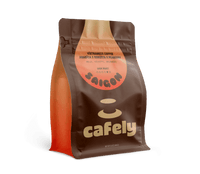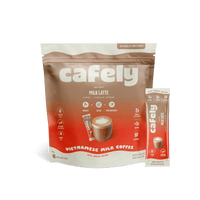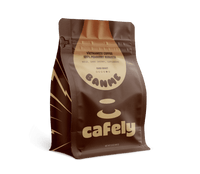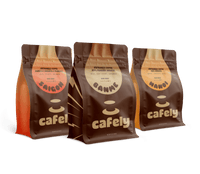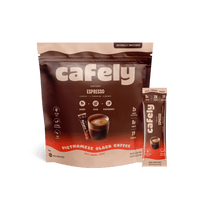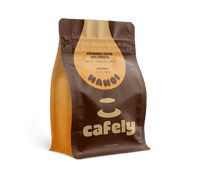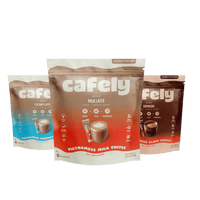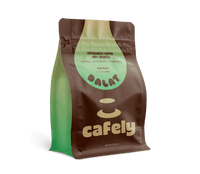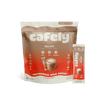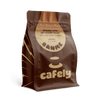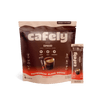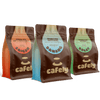You’ve been there, staring at the menu, not sure which coffee to order…
Cappuccino? Macchiato? Both sound fancy, but they’re not the same at all.
Some days you want something creamy, velvety, and indulgent. Other times, you just need a strong shot of espresso without any extras. That’s where knowing the difference helps.
This guide clears everything up. You’ll learn how much milk goes into each drink, how they taste, their strength, and which one fits your mood, so there’s no guessing next time you order.
Quick Summary: Main Differences Between A Cappuccino & Macchiato
It’s simple, one has way more milk than the other:
- A cappuccino mixes espresso, steamed milk, and foam in equal parts. It tastes smooth, light, and mellow. You get that cozy, café-style feeling in every sip. If you want creamy comfort, grab a cappuccino.
- A macchiato coffee keeps it short and bold. You get mostly shot of espresso with just a little milk foam on top. It’s strong, rich, and meant for quick sipping. If you want a strong coffee punch with a hint of creaminess, go for a macchiato.
Cappuccino vs Macchiato: Milk & Texture

Cappuccino and macchiato both start with a shot of espresso, but that's where the similarity ends.
A cappuccino uses a lot more milk. You take one shot of espresso and add equal parts steamed milk and thick, airy foam on top. This makes the drink soft, creamy, and light. The milk tones down the bitterness of espresso, giving you a smooth sip from start to finish.
An espresso macchiato keeps things much simpler. You pull a shot of espresso, then add just a little milk foam on top. The word "macchiato" means "stained" or "marked" in Italian — you're complementing the espresso with milk, not covering the coffee's flavor up. The drink stays intense, bold, and mostly espresso-forward.
There’s also the latte macchiato, which you’ll find in chains such as Starbucks. This flips the order around. You steam a full glass of milk first, then pour a shot of espresso on top. This provides a layered effect, with a softer flavor than a regular macchiato.
To make it simple:
- Cappuccino— Creamy, soft, lots of milk and foam.
- Espresso Macchiato — Small, strong, just a dot of milk foam.
- Latte Macchiato— Mostly milk, with a light touch of espresso on top.
Cappuccino vs Macchiato: Flavor Strength & Size
The milk amount changes how each drink feels.
A cappuccino feels light and velvety. You get some coffee flavor, but it’s mellowed out by the creaminess of the milk. The foam adds airiness, so every sip feels soft, not heavy. If you want a relaxing, smooth drink to sip slowly, a cappuccino delivers.
A macchiato hits differently. The small amount of milk doesn’t cover the strong flavors of the espresso. You still get the full, rich espresso flavor, strong, slightly bitter, and sharp. The foam softens it just a little, but you’ll definitely feel that strong coffee punch.
If you try a latte macchiato, it’s much milder. The large amount of steamed milk makes it sweeter and softer, especially if you add syrup or flavors.
Let’s break it down in simple numbers so it’s easy to remember.
Cappuccino:
- Size — About six ounces.
- Milk — Two parts milk to one part coffee.
- Texture — Creamy, foamy, soft.
- Flavor — Mellow espresso flavor, perfect for sipping slowly.
Espresso Macchiato:
- Size — Two to three ounces.
- Milk — Just a teaspoon of milk foam.
- Texture — Sharp, clean, mostly espresso.
- Flavor — Bold, concentrated, intense.
Which One Has More Caffeine?
Both cappuccino and macchiato start with the same base — a shot of espresso.
A standard espresso shot contains around 60 to 75 milligrams of caffeine. This doesn’t change between the two drinks because it comes from the espresso itself.
The difference is in how it feels when you drink it.
A macchiato feels stronger because it barely has any milk. You get the full espresso flavor in a small amount of liquid, usually just two to three ounces total. There’s no milk to mellow it out, so each sip hits harder, both in flavor and perception of strength.
A cappuccino softens the intensity. You still get one shot of espresso, but it’s balanced with equal parts steamed milk and foam. The total drink is about six ounces, making the caffeine feel less intense, even though it’s the same amount.
If you order a double shot in either drink, caffeine doubles to 120 to 150 milligrams. The same rule applies — macchiato stays bold, cappuccino stays balanced.
Put Simply:
- Macchiato — 60 to 75 mg caffeine, feels stronger due to less milk.
- Cappuccino — 60 to 75 mg caffeine, feels smoother because of milk.
If you want the full caffeine impact, go for a macchiato.
If you want a mellow taste with the same caffeine kick, choose a cappuccino.
Which Should You Choose?
Choosing between cappuccino and macchiato depends on what you’re looking for in a drink — flavor strength, milk content, and even how much time you have.
Choose a Cappuccino If You Want:
- A smooth, café-style drink that feels light and satisfying.
- A warm, balanced flavor where the coffee doesn’t overpower.
- Something mellow for mornings when you want comfort, not intensity.
- A drink that lasts longer — six ounces is enough to sip and enjoy slowly.
- More creaminess, perfect for relaxing or pairing with breakfast.
Choose a Macchiato If You Want:
- A strong espresso kick with no distractions.
- A quick, low-calorie caffeine fix, ideal if you’re cutting back on milk.
- Minimal milk, maximum coffee flavor, where you taste the beans directly.
- A drink you can finish in a few sips — great if you’re short on time.
- Fewer calories — a traditional macchiato only has a splash of milk, making it lighter.
Nutritional Information: Cappuccino vs. Macchiato
If you also care about calories and nutrition, here’s a quick breakdown:

How to Make a Cappuccino at Home
A cappuccino is known for its creamy, balanced taste. You get equal parts espresso, steamed milk, and foam in every sip.
Here’s how to make a cappuccino at home:
Step 1: Brew 1 to 2 Shots of Espresso
Start by brewing a fresh shot of espresso. Use an espresso machine if possible. If you don’t have an espresso machine, a moka pot, or an Aeropress, you can produce a similar coffee. Aim for a strong, smooth base. A single shot is about one ounce, but you can use two shots if you like it stronger.
Step 2: Steam and Froth the Milk
Pour cold milk into a pitcher. Whole milk creates the creamiest foam, but oat milk or other plant-based options also work. Use a steam wand to heat the milk to about 150°F.
If you don’t have a steam wand, use a milk frother or heat the milk on the stove and whisk it until foamy.
Step 3: Create a Thick Foam
You want two layers in your milk — smooth, velvety steamed milk and dense microfoam. Tilt the pitcher to swirl the milk and separate the foam on top.
Step 4: Pour in Layers
First, pour your espresso into a six-ounce cup. Then, add the steamed milk slowly. Finally, spoon the thick foam on top to finish the drink.
Optional — dust with cocoa or cinnamon.
How to Make an Espresso Macchiato at Home
An espresso macchiato keeps things simple. It’s a small drink, bold and quick to make.
Step 1: Brew a Fresh Espresso Shot
Use your favorite method to brew a shot of espresso. A single shot works best here because the goal is a strong, concentrated coffee.
Step 2: Add a Dollop of Milk Foam
Froth a small amount of milk, just enough to create foam. You can use a steam wand or a handheld frother. Once your espresso is ready, spoon a small layer of microfoam on top.
That’s it, small, strong, and ready to sip.
How to Make a Latte Macchiato
The latte macchiato is a popular drink in coffee chains like Starbucks. It’s milky and mild, with pretty layers in the glass.
Step 1: Steam the Milk
Heat and froth a large amount of milk until it reaches 150°F. You’ll need more milk than the other drinks because this version uses espresso as a topping, not the base.
Step 2: Pour Milk Into a Glass
Fill your glass about three-quarters full with the steamed milk. Let it sit for a few seconds so the foam rises to the top.
Step 3: Slowly Pour the Espresso on Top
Brew a single shot of espresso and slowly pour it over the back of a spoon into the glass. This helps it float on top and creates the layered effect.
Step 4: Optional Flavor Extras
At home, you can drizzle caramel or add flavored coffee syrups before pouring the espresso. It’s an easy way to recreate café-style drinks with your own twist.
Now you’re ready to make cafe drinks at home.
Best Coffee for Cappuccino and Macchiato
To get the best-tasting cappuccino or macchiato, you’ll need high-quality coffee beans.
If you like a bold, complex cup, SaiGon OG is a great place to start. It combines robusta, arabica, and peaberry beans for an earthy base with smooth, floral notes.
If you want a balanced, medium-bodied flavor, the DaNang mixes arabica and robusta beans for a smooth drink with just enough boldness to stand out.
If you prefer something rich and silky, go for DaLat. These 100% Vietnamese arabica beans from Da Lat give you a smooth, decadent flavor with hints of caramel, blackberry, and stone fruit.
Pick your beans and enjoy experimenting, and you’ll learn to master each drink in no time.
FAQs: Cappuccino vs Macchiato

Here are quick answers to common questions about cappuccino and macchiato:
1. Is Macchiato Stronger Than Cappuccino?
Yes. Macchiatos feel stronger because they have much less milk. The espresso flavor stays bold and concentrated.
2. What Is the Strongest Coffee With Milk?
A macchiato or a cortado. Both drinks have more espresso and less milk, keeping the flavor intense.
3. Which Coffee Drink Has the Least Milk?
The espresso macchiato. It only has a small touch of milk foam on top.
4. Which Coffee Has the Most Caffeine?
Cold brew tends to have the most caffeine by volume. Or, any drink with multiple espresso shots, like flat whites or large lattes.
5. What Does Lungo Mean in Coffee?
A lungo is an espresso made with more water. It creates a longer, larger shot that tastes slightly more bitter.
6. Who Makes the Best Macchiato in the World?
Taste always depends on you, but many people love traditional Italian cafés and small artisan shops for their macchiatos.
7. How Are You Supposed to Drink Macchiatos?
Sip it slowly. This lets you enjoy the bold espresso flavor mixed with just a hint of soft milk foam.
8. What Is the Tastiest Milk for Coffee?
Whole milk gives the creamiest texture. Many people also like oat milk for its sweet, nutty flavor.
9. What Is the Most Popular Coffee in the World?
Espresso is the most popular base for drinks, especially across Europe and Latin America.
10. Does a Darker Roast Mean More Caffeine?
No. Dark roasts taste stronger, but they usually have slightly less caffeine than light roasts.
